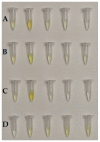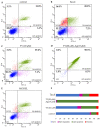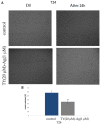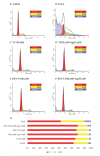Antibacterial Therapy by Ag+ Ions Complexed with Titan Yellow/Congo Red and Albumin during Anticancer Therapy of Urinary Bladder Cancer
- PMID: 35008445
- PMCID: PMC8744882
- DOI: 10.3390/ijms23010026
Antibacterial Therapy by Ag+ Ions Complexed with Titan Yellow/Congo Red and Albumin during Anticancer Therapy of Urinary Bladder Cancer
Abstract
According to the World Health Organization report, the increasing antibiotic resistance of microorganisms is one of the biggest global health problems. The percentage of bacterial strains showing multidrug resistance (MDR) to commonly used antibiotics is growing rapidly. Therefore, the search for alternative solutions to antibiotic therapy has become critical to combat this phenomenon. It is especially important as frequent and recurring infections can cause cancer. One example of this phenomenon is urinary tract infections that can contribute to the development of human urinary bladder carcinoma. This tumor is one of the most common malignant neoplasms in humans. It occurs almost three times more often in men than in women, and in terms of the number of cases, it is the fifth malignant neoplasm after prostate, lung, colon, and stomach cancer. The risk of developing the disease increases with age. Despite the improvement of its treatment methods, the current outcome in the advanced stages of this tumor is not satisfactory. Hence, there is an urgent need to introduce innovative solutions that will prove effective even in the advanced stage of the disease. In our study, a nanosystem based on ionic silver (Ag+) bound to a carrier-Titan yellow (TY) was analyzed. The possibility of binding the thus formed TY-Ag system to Congo red (CR) and albumin (BSA) was determined. TY-Ag binding to CR provides for better nanosystem solubility and enables its targeted intracellular transport and binding to immune complexes. The binding of TY-Ag or CR-TY-Ag to albumin also protects the system against the uncontrolled release of silver ions. It will also allow the delivery of silver in a targeted manner directly to the desired site in the case of intravenous administration of such a system. In this study, the MIC (Minimum Inhibitory Concentration) and MBC (Minimum Bactericidal Concentration) values of the TY-Ag or BSA-TY-Ag systems were determined in two reference strains (Escherichia coli and Staphylococcus aureus). The paper presents nanosystems with a size of about 40-50 nm, with an intense antibacterial effect obtained at concentrations of 0.019 mM. We have also discovered that TY-Ag free or complexed with BSA (with a minimal Ag+ dose of 15-20 μM) inhibited cancer cells proliferation. TY-Ag complex diminished migration and effectively inhibited the T24 cell viability and induced apoptosis. On the basis of the obtained results, it has been shown that the presented systems may have anti-inflammatory and antitumor properties at the same time. TY-Ag or BSA-TY-Ag are new potential drugs and may become in future important therapeutic compounds in human urinary bladder carcinoma treatment and/or potent antimicrobial factors as an alternative to antibiotics.
Keywords: Escherichia coli; Staphylococcus aureus; T24 cell line; apoptosis; bovine serum albumin; congo red; migration; minimum bactericidal concentration; minimum inhibitory concentration; necrosis; silver ions; titan yellow; tumor growth.
Conflict of interest statement
The authors declare no conflict of interest. The funders had no role in the design of the study; in the collection, analyses, or interpretation of data; in the writing of the manuscript, or in the decision to publish the results.
Figures
















Similar articles
-
Antimicrobial potency of differently coated 10 and 50 nm silver nanoparticles against clinically relevant bacteria Escherichia coli and Staphylococcus aureus.Colloids Surf B Biointerfaces. 2018 Oct 1;170:401-410. doi: 10.1016/j.colsurfb.2018.06.027. Epub 2018 Jun 18. Colloids Surf B Biointerfaces. 2018. PMID: 29945052
-
Gelatin-based films containing clinoptilolite-Ag for application as wound dressing.Mater Sci Eng C Mater Biol Appl. 2020 Feb;107:110215. doi: 10.1016/j.msec.2019.110215. Epub 2019 Oct 31. Mater Sci Eng C Mater Biol Appl. 2020. PMID: 31761173
-
Antibacterial activity and mechanism of Ag-ZnO nanocomposite on S. aureus and GFP-expressing antibiotic resistant E. coli.Colloids Surf B Biointerfaces. 2014 Mar 1;115:359-67. doi: 10.1016/j.colsurfb.2013.12.005. Epub 2013 Dec 18. Colloids Surf B Biointerfaces. 2014. PMID: 24412348
-
Nanotechnology as a therapeutic tool to combat microbial resistance.Adv Drug Deliv Rev. 2013 Nov;65(13-14):1803-15. doi: 10.1016/j.addr.2013.07.011. Epub 2013 Jul 24. Adv Drug Deliv Rev. 2013. PMID: 23892192 Review.
-
Supramolecular Structures as Carrier Systems Enabling the Use of Metal Ions in Antibacterial Therapy.2017 Nov 4. In: Roterman I, Konieczny L, editors. Self-Assembled Molecules – New Kind of Protein Ligands: Supramolecular Ligands [Internet]. Cham (CH): Springer; 2018. Chapter 6. 2017 Nov 4. In: Roterman I, Konieczny L, editors. Self-Assembled Molecules – New Kind of Protein Ligands: Supramolecular Ligands [Internet]. Cham (CH): Springer; 2018. Chapter 6. PMID: 31314355 Free Books & Documents. Review.
Cited by
-
Recent Advancements in Sensing of Silver ions by Different Host Molecules: An Overview (2018-2023).J Fluoresc. 2025 Jan;35(1):267-289. doi: 10.1007/s10895-023-03494-8. Epub 2023 Dec 1. J Fluoresc. 2025. PMID: 38038876 Review.
-
Loading of green-synthesized cu nanoparticles on Ag complex containing 1,3,5-triazine Schiff base with enhanced antimicrobial activities.Sci Rep. 2023 Nov 21;13(1):20421. doi: 10.1038/s41598-023-47358-4. Sci Rep. 2023. PMID: 37989862 Free PMC article.
References
-
- World Health Organisation (WHO) Antibiotic Resistance: Multi-Country Public Awareness Survey. WHO; Geneva, Switzerland: 2015.
-
- World Health Organisation (WHO) Antimicrobial Resistance: Global Report on Surveillance. WHO; Geneva, Switzerland: 2014.
-
- Vogel G. Meet WHO’s dirty dozen: The 12 bacteria for which new drugs are most urgently needed. Science. 2017;354:6328. doi: 10.1126/science.aal0829. - DOI
-
- Taconelli E., Margini N. Global Priority List of Antibiotic-Resistant Bacteria to Guide Research, Discovery, and Development of New Antibiotics. WHO; Geneva, Switzerland: 2017.
MeSH terms
Substances
Grants and funding
LinkOut - more resources
Full Text Sources
Medical

